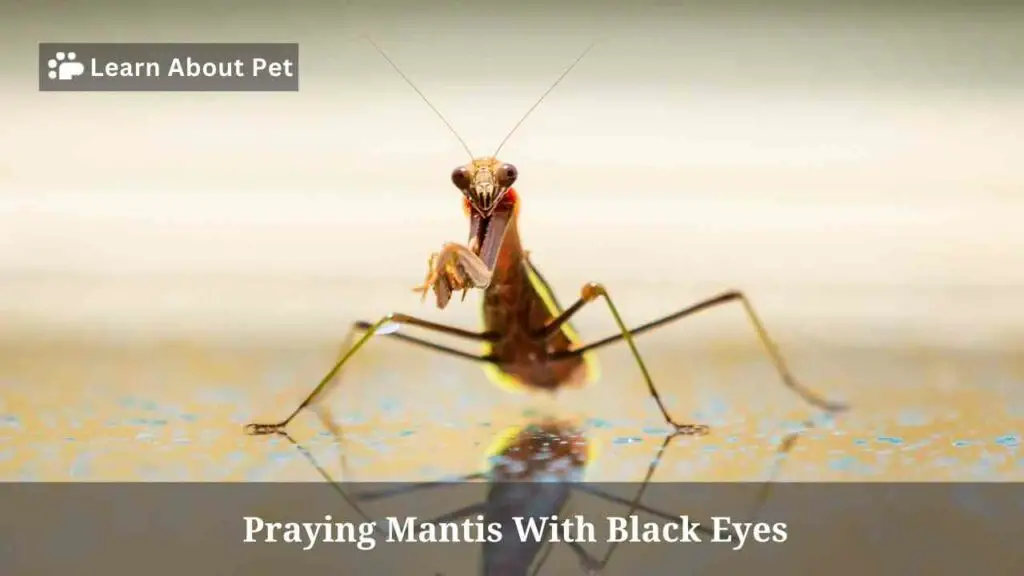Praying mantis are fascinating insects that have extraordinary hunting abilities and captivating appearance. No wonder many pet owners are interested in caring for praying mantis as their pets.
Praying mantis are iconic because their stance and forelegs seem ready to lunge at anything against them while their sharp eyes look around. The two large compound eyes are straightforward, so the eye color of the praying mantis’ eyes is clear.
Sometimes, we can see praying mantis with black eyes. What does that mean? There are several possibilities for praying mantis eyes to turn black. Some of them are signs of illness, dehydration, or adaptation to low light conditions. Praying mantis can change their eye colors to dark purple or black to see better in the dark. But if black eyes still occur in the day, it might have a fungal or bacterial infection.

Learning that praying mantises can have black eyes is new for some pet owners. Let’s discuss in more depth the change in mantis eyes from turning black.
Why Do Praying Mantis With Black Eyes Occur?
Pay attention to the room around your praying mantis, whether the room has low light or not. Praying mantis have incredible adaptations to adapt their eyes to low-light conditions.
When in darkness or dim light, the mantis eyes will gather pigments and cause a deepening of color. Mantis eyes both completely black, if exposed to dim light or darkness for half an hour or more.
The mantis initially had light colored eyes, and became ebony hue after in darkness. But after returning to bright light, the pigments dissipate, and return the condition of the mantis eyes to lighter shades.
What Kind Of Eyes Does A Praying Mantis Have?
Praying mantises have two ball-shaped eyes with black dots between them like pupils. The false pupil has a unique system and plays a significant role in the praying mantis when it wants to ambush its prey.
The eyes that face forward have a compound eye structure with many lenses called ocelli. The praying mantis can see a composite image of its surroundings up to a 240⁰ display with an overlap of 35⁰ at the front.
What Is The Black Dot On Mantis Eyes?
The black dot in the middle of the praying mantis’s eyes is like a pupil called a pseudopupil. It is a unique system that has thousands of tiny individual light receptors. The ommatidia or light receptors will absorb all the wavelengths so they look black.
The black spot moves across the eye as long as the mantis rotates. It occurs because ommatidia observe along their optical axes of the incident light while the other eyes reflect it.
Are Black Eyed Praying Mantis Harmful?
It might be harmful if the black color in the mantis’ eyes does not change, even at night or during the day. There are two possibilities that occur if the mantis’ eyes remain black in normal light conditions due to dehydration or illness.
If the praying mantis continues in a state of dehydration or the disease is not getting better, praying mantis black death can occur.
Praying mantis cannot be used in environmental conditions that are too dry or where the humidity is not suitable. A praying mantis whose body is continuously dehydrated will turn black from its eyes to various parts of its body.
Why Do Praying Mantises’ Eyes Sometimes Appear To Be Black?
Praying mantis eyes turn black when in a low-light environment. Watch where the mantis is as their eyes turn black. Praying mantis will only change their eye color when in the dark or in dim light, because their eyes adapt to being able to see in the dark.
The praying mantis’ eye color will change to dark purple or black, but will return to lighter shades when it returns to a place with bright light.
Why Do Praying Mantis Eyes Turn Black?
After knowing several possible causes of praying mantis eyes turning black, we will summarize them in the table below.
| Praying mantis with black eyes conditions | Explanation |
| Low light conditions | Mantis compound eye features adapt to light conditions, allowing them to see in the dark. |
| Dehydration | Praying mantis do not get enough water for their needs. |
| Illness | Bacteria or fungal infection makes praying mantis’ eyes remain black and makes their vision impaired. |
| Pseudopupil effect | The presence of black dots in the mantis’ eyes is an ommatidia that aligns in a way that absorbs all wavelengths of light, creating a dark spot or pseudopupil. |
Why Do Mantis Eyes Turn Black At Night?
Mantis will darken their eyes as a process to see better at night. Praying mantis will move the reflective pigment cells away so they can activate night vision mode.
Praying mantis with dark eyes when there is no light or in a low-light environment is common. There’s nothing to worry about when the praying mantis’ eyes turn black at night.
Final Verdict
There are three main conditions when praying mantis eyes turn black. Praying mantis is in a dark room or outside with minimal light, signs of dehydration, or illness due to bacteria or fungal infection. Praying mantis will only change their eyes when in low light conditions.
If the praying mantis still has black eyes, then you have to provide special needs for the mantis. Provide enough water and treat the mantis until it recovers from fungal or bacterial infections.

Welcome to Learn About Pet. My name is Rajkumar Ravichandran and I love all pets, travel, and amazing food. I write about my passion and personal experience caring for multiple pets in this blog! ❤️
Post Disclaimer
DISCLAIMER: THIS BLOG OR WEBSITE, "Learn About Pet", DOES NOT PROVIDE YOU WITH MEDICAL ADVICE AND IS NOT A SUBSTITUTE FOR MEDICAL ADVICE. ALWAYS GET IN TOUCH WITH YOUR PERSONAL VETERINARIAN AND USE INFORMATION HERE AS GENERAL ADVICE.
The information, including but not limited to, text, graphics, images and other material contained on this website are for informational purposes only. No material on this site is intended to be a substitute for professional veterinary advice, food recommendation, diagnosis, or treatment. Always seek the advice of your veterinarian or other qualified health care provider with any questions you may have regarding a medical condition or for pet food related questions.







